Vision Impairments from Birth Injuries
Most of the time, healthcare professionals such as OB/GYNs, nurses, technicians, and other providers deliver babies that are healthy and ready for the world. However, there are other times when medical professionals make mistakes or fail to address known complications during the delivery process that lead to adverse outcomes for the newborn.
In some cases, the negligence of physicians and other healthcare providers can cause a baby to be born with a significant birth injury such as damage to their eyes or severe vision impairments.
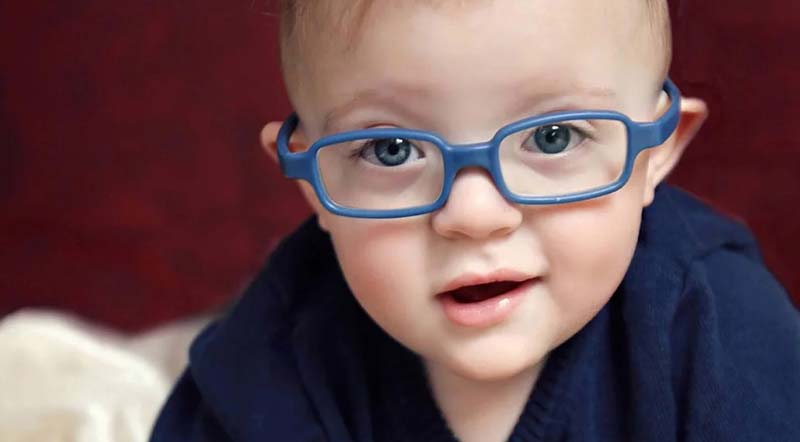
According to the American Academy of Ophthalmology, approximately 80% of all learning during a child’s first 12 years happens through their eyesight. Therefore, vision loss at or before birth can negatively affect a child's development socially, physically, educationally, and psychologically.
Neonatal and childhood healthcare professionals are responsible for remaining alert to ophthalmological conditions in newborns and referring them to the appropriate specialists immediately after finding infant vision problems. When maternity, neonatal, medical/surgical, or ophthalmic care errors result in vision problems or blindness, the victim may be entitled to compensation to help cover the cost of medical expenses, ongoing treatment, and other injury-related damages.
Birth Complication Lawyers
1-888-987-0005The birth injury attorneys at Miller Weisbrod Olesky are dedicated to providing compassionate legal support to families and their children living with a birth injury, such as cerebral palsy.
At Miller Weisbrod Olesky, our birth injury lawyers understand that no amount of compensation can fully make up for the physical and emotional toll that a birth injury can take on the affected individual and their family. However, we remain committed to fighting for our client's rights and ensuring they receive the support and resources they need to rebuild their lives and secure their futures.
What Are Visual Impairments?

Vision impairment can range from poor vision or an inability to see particular colors (color blindness) to no vision (blindness). Low or poor vision is a permanent visual impairment that ordinary glasses, contact lenses, medication, or surgery cannot correct. People with low vision, blurred vision, or loss of side vision may find it challenging to do everyday activities, even with glasses or contact lenses, such as reading a newspaper. Blindness is defined as a lack of vision or complete inability to see.
If a child is partially blind, they have very limited vision and may be able to only see shapes, general colors, or changes in lighting. Complete blindness is when a child is unable to see anything, including light. Visual impairments and blindness in children may result from genetic or prenatal factors. Unfortunately, in other situations, blindness and visual impairments may be caused by the negligent or careless actions of medical professionals, such as a failure to intervene when complications arise during labor and delivery.
Types of Vision Impairments Caused by Birth Injuries
Birth injuries can have a profound impact on a child's vision, leading to various types of vision impairment. These impairments can range from mild to severe and may include conditions such as cortical visual impairment (CVI), ophthalmia neonatorum, and retinopathy of prematurity (ROP). Understanding the potential vision impairments that can be caused by birth injuries allows healthcare professionals to provide appropriate treatments and support to minimize the impact on a child's visual development.
Cortical Visual Impairment (CVI)

Cortical visual impairment (CVI) or cortical blindness is a neurological disorder caused by damage to the visual systems in the brain. It is the leading cause of permanent visual impairment in children. The word cortical refers to the visual cortex, which is the region of the brain responsible for processing and interpreting visual information from the eyes.
Normally, the eyes send electrical signals to the brain, and the brain interprets those signals as images. However, if a child has cortical vision impairment, their brain has trouble processing what they are seeing. Several types of visual impairment may result from damage to the visual cortex. Some of these include low vision, impaired visual processing, and decreased perception and field of vision.
Most cases of CVI among children occur as a result of trauma during birth, involving:
- Complications associated with premature birth
- Oxygen deprivation/birth asphyxia
- Periventricular Leukomalacia (PVL)
- Hypoxic-ischemic encephalopathy (HIE)
- Neonatal hypoglycemia
- Hydrocephalus
- Cerebral vascular accident
- Head injury (CBI)
- Epilepsy
- Infections of the central nervous system (meningitis and encephalitis)
Children who suffer from CVI usually have cerebral palsy (CP) and other developmental disabilities commonly caused by birth injuries. CVI can have devastating long-term effects on a child's life. When careless mistakes made by an OB/GYN or another medical professional during labor and delivery cause your child to suffer from impaired vision or blindness, you should reach out to a knowledgeable birth injury lawyer who will conduct a thorough investigation and build a strong case on your behalf to hold all negligent parties accountable for their actions.
Ophthalmia Neonatorum
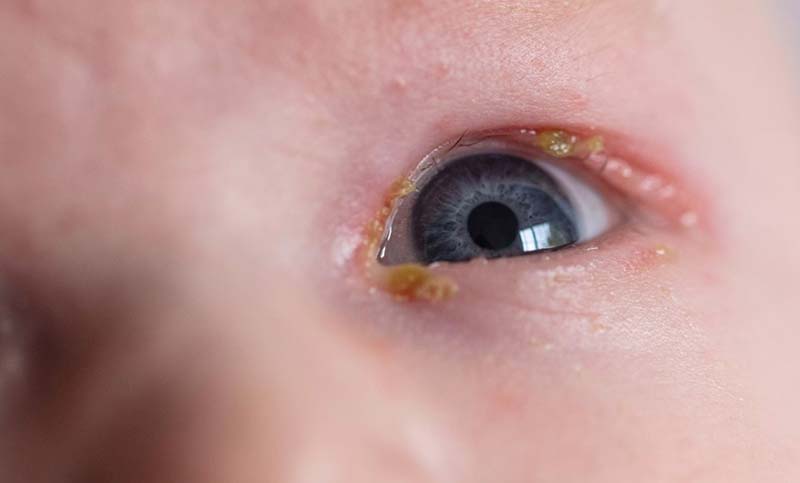
Babies can be affected by maternal infections if a doctor fails to diagnose and treated the infection promptly. An infant may develop a condition called ophthalmia neonatorum (neonatal conjunctivitis) within the first month of life if they acquire a bacterial, chlamydia, or viral infection as they pass through an infected birth canal.
The most common causes of neonatal conjunctivitis are chlamydial conjunctivitis, gonococcal (gonorrhea) conjunctivitis, chemical conjunctivitis, or conjunctivitis caused by viruses that cause genital or oral herpes. In some cases, newborns with chlamydial conjunctivitis can have the infection in other parts of their bodies, such as their lungs (pneumonia) and nasopharynx.
Doctors should screen all pregnant women for sexually transmitted infections, like gonorrhea and chlamydia, and provide necessary treatments to avoid causing permanent visual impairments or blindness in infants and newborns. A physician should run tests on an infant showing signs of ophthalmia neonatorum to determine the underlying cause. Some common symptoms of ophthalmia neonatorum that doctors and other healthcare providers should look for include swollen or puffy eyelids, redness in one or both eyes, discharge, or a thick-pus-like drainage from the eyes.
Retinopathy of Prematurity (ROP)
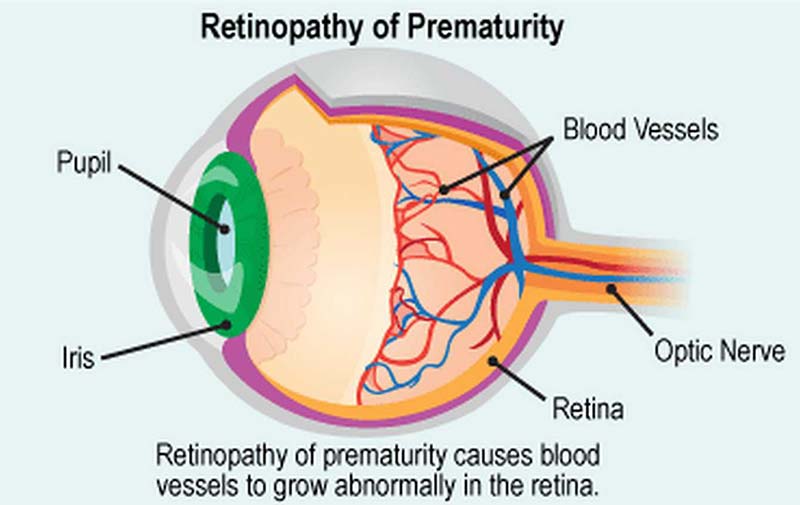
In developed countries, retinopathy of prematurity (ROP) causes 6-18% of all cases of blindness. Approximately 400 to 600 infants become blind from ROP each year in the United States. Infants who are born prematurely or have very low birth rate are at an increased risk for developing retinopathy of prematurity. Of the estimated 14,000 preterm babies born in the U.S., an estimated 10% develop severe ROP.
Premature babies are more susceptible to developing conditions that affect their eyesight, like ROP, because the blood vessels in their retinas have not fully developed. After premature birth, those vessels continue to form but may develop abnormally. If not identified early and treated properly, the abnormal blood vessels that develop around the eye can cause pressure and permanent damage to the retina. In the worst-case scenario, the development of these abnormal blood vessels can lead to detachment of the retina and, ultimately, blindness.
Medical practitioners who work with premature babies are responsible for properly monitoring them and providing prompt treatment when necessary. Other risk factors for ROP at birth are respiratory distress syndrome (RDS), infections like an STI in the mother, and intracranial hemorrhage. Additionally, while oxygen can be a lifesaving treatment for newborns with respiratory issues, ROP can be caused by too much exposure to oxygen if it is not carefully controlled.
The abnormal retinal blood vessels in infants with mild cases of retinopathy of prematurity may heal on their own. However, infants with more severe cases of retinopathy of prematurity face a risk of retinal detachment, myopia, strabismus, amblyopia (lazy-eye), glaucoma, or blindness. If medical professionals fail to do all they can to prevent premature birth and it results in ROP, it may constitute medical malpractice. Parents of children who believe that their child's ROP was a result of medical malpractice should consult with a birth injury lawyer to explore their legal options and pursue compensation for their child's injuries and future medical needs.
Visual Impairment in Newborns Caused by Medical Malpractice
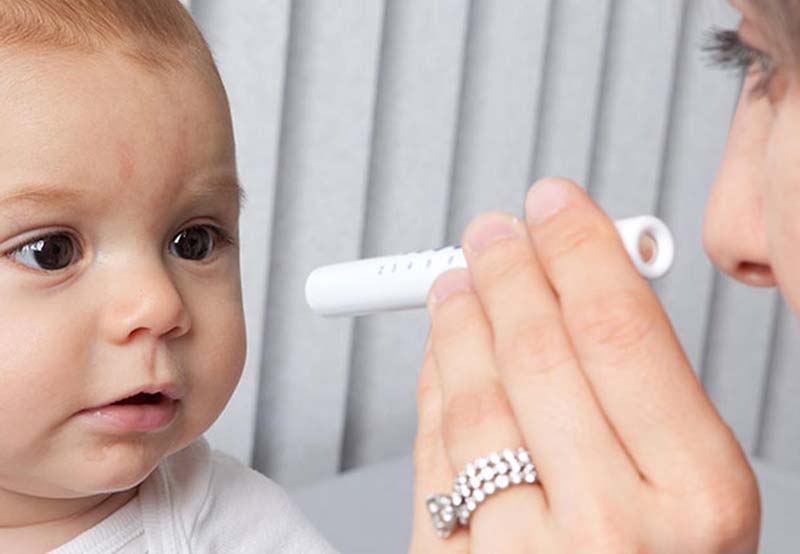
A baby's eyes are delicate and sensitive to pressure, friction, and other external forces. If doctors and other healthcare professionals do not provide sufficient care and attention to an expectant mother and her newborn during labor and delivery, it's easy for a newborn's eyes to become damaged, which can result in severe visual impairment or permanent blindness. There are two types of birth injury that are sometimes caused by medical malpractice, which can result in impaired vision in children or blindness.
The first is damage or traumatic injury to the eye, the visual center of the brain, or the pathways connecting the eye to the brain. An example of how an injury that triggers sight loss may occur at birth is through the improper use of tools such as a vacuum extractor or forceps.
Medical conditions that are not properly detected, treated, or managed are the second type of medical malpractice that can result in injuries to the eyes. One example of this is the baby contracting an eye infection in the birth canal, such as newborn conjunctivitis, from a mother with a sexually transmitted disease (STD) or infection (STI). Delays in diagnosing or treating infections with particular viruses during pregnancy can cause damage to the newborn's optic nerve and lead to impaired vision.
Additional examples of medical negligence that can result in impaired vision or blindness in children include:
- Failure to recognize and respond to signs of fetal distress
- Delay in carrying out an emergency C-section
- Failure to diagnose or treat Retinopathy Of Prematurity (ROP)
- Failure to respond to and timely treat perinatal asphyxia
- Inadequate fetal monitoring
- Failure to diagnose and treat medical conditions in the mother, such as low blood pressure, heart disease, or anemia
- Failure to perform timely and appropriate neonatal resuscitation
- Failure to diagnose or treat umbilical cord complications such as umbilical cord compression or prolapse
- Failure to monitor and respond to signs of uterine tachysystole
- Failure to properly administer labor-inducing drugs like Pitocin or Cytotec
- Failure to identify and immediately treat placental abruption
- Failure to diagnose or treat infections such as newborn meningitis or encephalitis. These infections can cause inflammation within or around the brain, resulting in partial or complete sight loss
- Failure to detect or properly manage conditions that commonly affect premature babies, like jaundice and kernicterus. Kernicterus is the name given to a type of brain damage that occurs when a baby has too much bilirubin in their blood (hyperbilirubinemia). If the baby's liver is unable to process all the bilirubin, it can penetrate the blood-brain barrier and cause visual impairment along with severe neurological disability

- Failure to adequately monitor or treat neonatal hypoglycemia (low blood glucose or sugar). When the newborn's blood sugar drops below a safe level, they can suffer severe neurological injury, which may result in cortical blindness or visual impairment
Blindness and sight impairment in newborns may arise from damage to the brain or the visual cortex caused by oxygen deprivation during birth. A baby suffering from asphyxia or hypoxia at birth will have an abnormal or low heart rate, cry weakly, gasp for breath, have pale or bluish skin, and weak reflexes.
Most commonly, negligent mistakes in maternity or neonatal care cause babies to suffer vision impairments and severe neurological disability, such as cerebral palsy. It is crucial for parents of children who have suffered vision impairments from birth injuries to seek legal assistance and hold all responsible parties accountable. A knowledgeable birth injury malpractice attorney can help families of children affected by birth injuries navigate the complex legal process and fight for the compensation and justice they deserve.
Signs of Vision Problems in Infants

Vision impairment can happen at any age, and while some conditions might result in vision problems for a short time, most conditions in children stay the same throughout life. Children with vision impairment might have typical-looking eyes. However, the way a child behaves or uses their eyes might indicate that there is a problem with their vision. By 4-5 weeks of age, most babies start to focus on faces, and by 6-8 weeks, most babies will start smiling at familiar faces and things they see.
However, if a child has vision impairment, their eyes might:
- Move quickly from side to side (nystagmus)
- Have trouble following a face or an object
- Fail to make eye contact with family and friends
- Turn in towards their nose or drift outwards towards the side of their face
- Their pupils may seem white or cloudy
Many areas of the child's development may be affected by impaired vision; some of these include:
- Socializing: The child may not notice someone smiling/waving at them and have trouble making friends
- Playing: The child may face challenges with spatial awareness and hand-eye coordination. Touching certain textures or simple activities like catching a ball may require additional support
- Talking: Visual cues and gestures play a crucial role in language acquisition. A child with visual impairments may struggle to mimic speech and grasp the nuances of language
- Movement: The child may have trouble sitting, crawling, or walking
- Day/Night Confusion: The child may find it difficult to differentiate between night and day
- Reading and Writing: The child may struggle with reading standard or enlarged print. Low vision devices such as video magnifiers can enhance the child's ability to read and write
A child with severe vision loss or blindness is likely to experience delays in certain areas of development and learning compared to their peers who do not live with visual impairments. The first step to finding the right treatment options and intervention is to determine the extent of their visual impairment and identify any underlying causes with early diagnosis.
To help a child with impaired vision reach their full potential, it is essential to provide them with the appropriate resources, such as therapies, specialized educational support, and assistive technology like vision-impaired keyboards. If you're worried about your child's vision, you should send them to an eye specialist who will conduct a thorough examination and perform various tests to assess their visual health and acuity.
Diagnosing and Treating Impaired Vision in Children

Many doctors fail to recognize signs of visual impairments in babies, prolonging their suffering and allowing crucial time to pass before initiating treatment that may prevent further harm. Although it can be challenging to identify sight impairment or blindness in infants and children, early detection can lessen some developmental, social, and economic struggles sight-impaired children may suffer later in life. A doctor who suspects a child may be vision impaired can further investigate by running several tests.
Eye tracking can be checked with a simple physical assessment where the infant's eyes are dilated and are directed to follow toys or drawings placed in their view. Some conditions, like cataracts, however, must be evaluated under anesthesia. Many cases of childhood blindness are caused by cataracts. Within four months of birth, infants with congenital cataracts should have corrective surgery and be given glasses.
Around two years after cataract removal, most children receive a permanent artificial lens, called an intraocular lens (IOL), to salvage sight. Another congenital disease that requires surgery and medication is infantile glaucoma. Early intervention is crucial when this condition arises to avoid blindness.
In the first few weeks of life, premature infants should be screened for injuries and conditions that could lead to blindness. In some cases, potential birth defects may be predicted even before delivery by reviewing an expectant mother's medical history and symptoms. Some conditions, like neonatal conjunctivitis, need to be treated pre-delivery with antibiotics that are given to the mother to prevent the transmission of a sexually transmitted disease (STD) to the baby. A newborn may require immediate eye cleansing and topical antibiotics to prevent neonatal conjunctivitis post-delivery.
Pediatric eye exams are essential to early detection and prevention of vision problems that could worsen if left untreated. Additionally, vision aids, like glasses, or other methods for improving vision, like surgery and therapy, can help maintain sight in some cases or encourage adaptation.
Leading Causes of Birth Injury Malpractice
When doctors, nurses, or other healthcare professionals commit medical negligence before, during, or after delivery, it can result in injuries to a mother, her child, or both. Even though not every birth injury is caused by medical malpractice, an experienced birth injury attorney can help make sure your child is compensated fairly if their provider was negligent in their care.
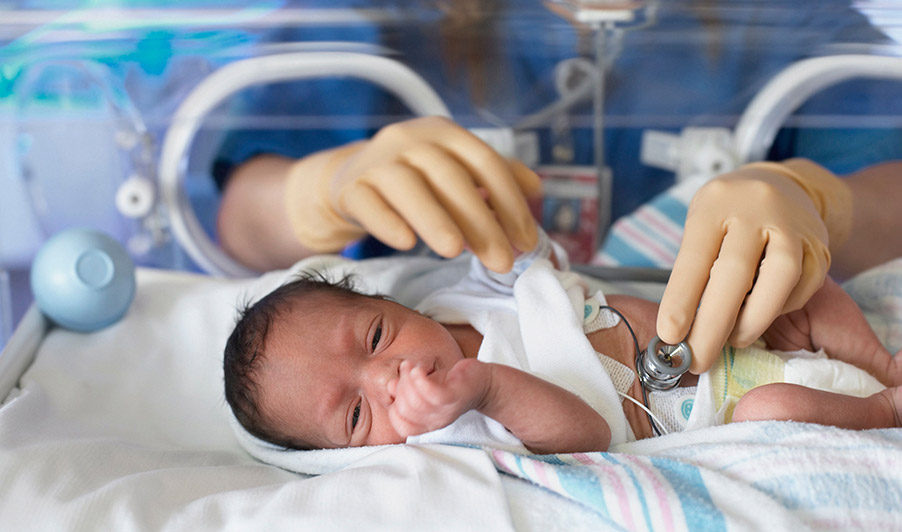
There are several examples of acts of medical negligence that can cause birth injuries during childbirth:
- Failure to recognize and treat signs of maternal or fetal distress, such as lack of oxygen
- Improper use of forceps or a vacuum extractor
- Using too much force during delivery
- Failure to schedule an emergency cesarean section (C-section)
- Delaying in performing an emergency C-section
- Failure to properly monitor the mother during her pregnancy
- Failure to administer the proper antibiotics or administering the wrong antibiotics to a mother with an STD or other maternal infections before delivery
- Ignoring or misreading a fetal monitoring strip
- Failure to detect and treat an umbilical cord complication
- Failure to diagnose and treat preterm labor in a timely manner
- Failure to treat maternal elevated blood pressure (preeclampsia)
- Failure to properly resuscitate a newborn after delivery
- Failure to treat jaundice and kernicterus
- Failure to respond to signs of a placental abruption
- Failure to detect a severe birth defect on a prenatal ultrasound
- Failure to carefully manage an abnormal fetal position
- Administering too high a dose of labor-inducing medications like Pitocin
Failing to address complications such as a preterm delivery or umbilical cord issues can result in a serious birth injury. As leaders in our communities, we rely on medical professionals to provide high-quality health care. Generally, when people think of medical malpractice liability, they picture doctors and nurses. However, other parties involved in the care of a pregnant woman and her baby may also be held responsible in a birth injury lawsuit.

Medical negligence may be committed by one or more of the following types of medical providers or facilities:
- Obstetricians (OB-GYN)
- Other obstetric professionals
- Pediatricians, including pediatric neurologists
- Anesthesiologists
- Labor and delivery nurses
- Midwives
- Nurses
- Hospitals and medical facilities
- Hospital administrators
- Other hospital staff
- Neonatal nurses and aids
- Neonatologists or pediatricians providing neonatal care
- Respiratory therapists
- Maternal-fetal medicine physicians and specialists (MFM)
- Laboratory staff
Although medical malpractice suits are often filed against healthcare providers like doctors and nurses, hospitals can also be held liable in certain circumstances. A hospital can be vicariously liable for an employee's negligent actions that caused harm during work hours or while the employee was performing a job-related task. For example, if an OBGYN makes a negligent mistake during pregnancy or delivery, the hospital can be held vicariously liable.
A hospital may also be held directly liable for its own actions. For instance, a hospital failing to adhere to medical protocols and standards may be directly liable for a patient's injuries. We can help you determine whether your child's birth injury was caused by a doctor, the hospital itself, or another medical professional.
When you file a birth injury malpractice claim, your lawyer must be prepared to present evidence that proves that a doctor's or hospital's negligence caused your child's birth injury. An injured plaintiff must be able to prove each of the following four legal elements in their birth injury lawsuit.
- Duty of care: Before the provider will have a duty of care, the plaintiff must be able to establish a provider-patient relationship. Upon establishing this relationship, the medical provider is expected to meet a relevant standard of care that a medical professional with the same specialization would have exercised under the same conditions.
- Breach: The next element the plaintiff must prove is that the healthcare provider or facility breached that duty by failing to meet the applicable standard of care.
- Causation: The plaintiff must then demonstrate that the healthcare provider's negligent care directly caused their or their child's injuries.
- Damages: Finally, the plaintiff must show that the harm they or their child suffered resulted in specific expenses and other losses. These losses may include anything from the cost of lifelong medical care to emotional suffering.
The plaintiff's attorney must present compelling evidence to establish liability and recover damages in birth injury cases. At Miller Weisbrod Olesky, our birth injury lawyers can collect evidence on your behalf, consult with medical experts to determine the cause of the injury, and identify all medical professionals who contributed to you or your child's birth injury.
Filing a Birth Injury Malpractice Lawsuit

Parents may file a birth injury lawsuit on behalf of their child against negligent medical professionals responsible for causing their child to sustain a preventable birth injury. Families may seek compensation to cover their child's medical and treatment costs through a Birth Injury Malpractice lawsuit.
It is important to note that while every case is different, most lawsuits typically follow a similar process. If your child was injured by a doctor, nurse, or other healthcare provider, an experienced birth injury lawyer can file your case, gather evidence, and pursue full and fair compensation on your behalf.
Free Case Review
Our dedicated birth injury lawyers will determine if you are eligible to file a birth injury lawsuit during your complimentary case review, which you can schedule by contacting us via our toll-free line at 888-987-0005 or by filling out our convenient online form. If we can determine that medical malpractice may have played a role in your child's birth injury, your case will likely be accepted by our team.
Gather Evidence
A birth injury malpractice attorney will gather information and evidence related to your case as soon as they determine you qualify to pursue a lawsuit. Evidence like medical records, witness statements, and the employment history of the medical professional in your case are crucial to proving that your child's birth injury was caused by medical negligence.
File the Lawsuit
After gathering the necessary information, your attorney will file your lawsuit in the appropriate court. As soon as the case is filed, you and your family will become the plaintiffs (the party taking legal action). The healthcare professionals who may be responsible for causing your child's injury will become the defendants (the party being sued). The statute of limitations in each state governs the deadline for filing a birth injury lawsuit.
Your lawyer will ensure your case is filed on time according to your state's statute of limitations. The lawsuit outlines the charges against the defendants and gives them around 30 days to respond. If the defendants fail to respond, judgment will automatically be entered in the plaintiff's favor. In the event the defendants respond but fail to assume responsibility, they will explain why they believe they are not to blame for your child's injury.
Discovery
Your attorney will gather more evidence, such as medical records, medical expense reports, and other documents related to your case, once the defendants file their response. During this time, you, your loved ones, and medical experts may be required to give statements under oath. The parties will also exchange information and evidence relevant to their respective cases to build strong arguments. To prove that medical professionals failed to uphold a high standard of care, an experienced attorney will collect all legally required evidence.
Settlement Negotiations
Settlement negotiations can begin once both parties have prepared their cases. During this phase, both parties will try to reach an agreement (settlement) that allows them to resolve their dispute without going through a full trial. Should a settlement be reached, the defendants will pay you a lump sum, and all legal action will stop. If the case cannot be resolved during this stage, our lawyers have the experience and knowledge to represent your best interests in court.
Go Through a Trial
Cases that do not settle through settlement negotiations will go to trial. A jury and judge will examine all the evidence presented by both legal teams during the trial. A verdict is reached after each party has presented their case and a judgment has been entered. The losing party may decide to appeal the decision in some cases. The disadvantage of trials is that, while you might receive more compensation than you would receive from a settlement, you risk receiving no compensation at all if you lose. Our lawyers can help you obtain the compensation you need to cover the cost of your child's care and other injury-related expenses.
Birth Injury Malpractice Statute of Limitations

A statute of limitations is a law that imposes a deadline for filing birth injury lawsuits. If you fail to file a claim before the statute of limitations "runs out", you may lose your right to pursue legal action and seek compensation. In some cases where an injury may not be immediately apparent, the statute of limitations may be extended.
The discovery rule prevents the statute of limitations from running until the injury is discovered or reasonably should have been discovered. It is also important to remember that the statute of limitations varies by state and the type of claim you're filing. A birth injury attorney can help you avoid missing all crucial deadlines related to your case.
Legal Help for Children With Visual Impairment Resulting from Medical Negligence

Blindness and visual impairments that stem from acts of medical malpractice near the time of birth are devastating and can have lifelong consequences for the affected individual and their families. Learning to live with blindness or impaired vision takes time and requires considerable resources, care, support, and therapy. At Miller Weisbrod Olesky, our birth injury attorneys are committed to helping visually impaired children rebuild their lives by fighting for the justice and compensation they deserve.
With the help of our in-house team of registered nurses and nurse-attorneys, we will conduct a thorough review of your case, gather evidence, and consult with experts to determine whether a doctor, hospital or another medical professional failed you and your baby with vision impairments. Our clients are NEVER responsible for any upfront fees or costs unless we are successful. To schedule your free, no-obligation consultation today, call us at 888-987-0005 or complete our convenient online form.
